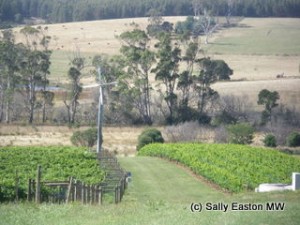Growing season temperature

North Tasmanian vineyard, with frost protection
Growing season temperature (GST) may just provide the most refined single index yet for identifying regions of cool and very cool climates. Work by Dr Andrew Pirie, honorary research associate at Tasmanian Institute of Agricultural Research, consultant at Tamar Ridge, and owner of Apogee, a single vineyard Tasmanian sparkling wine, has revised the index.
GST is calculated by taking the average temperature for each month of the seven month growing season (October to April in the southern hemisphere, and April to October in the northern hemisphere), divided by seven.
Other indices, such as heat degree days (HDD), developed in the 1940s for Californian wine growing regions provide the broadest brush indication of viticulture climate zones, but it lacks precision at the cooler end of the spectrum. Mean January (southern hemisphere)/July (northern hemisphere) temperature (MJT) are useful, but are thought not to work generally across the globe. Pirie cited the MJT cut-off of 18.7°C, below which it was considered too cool for viticulture, was based on observations at the cool limits in France. It would mean that all of Tasmania was ‘too cool for viticulture’, yet the island state has 1,400 hectares of vineyard.
Clearly for any index to be mainstream, it needs to work everywhere, and while Pirie said GST “seems to work universally”, he was careful to add that temperature alone does not fully define the viticultural environment. So while GST works within a normal range of rainfall and growing season solar radiation (GSS), Pirie’s work in progress includes adaptations of GST for such things as rain days, GSS, soil moisture content, and mean temperature of the coldest month. The latter, he said “is used to delineate areas too cold because of winter freeze.” He is also testing the hypothesis that “in low GST areas, a high GSS provides energy to warm bunches and soil, and improve ripening, as in Ranelagh” in southern Tasmania, which is cooler, but has more sunshine than Champagne.
Pirie’s revised GST model matches cultivars to climate zone, it “tells you which grapes to grow, but it doesn’t tell you about wine style” he said. For this reason his model refines 13 to 14°C as ‘very cool’, with 14 to 16°C as ‘cool’ because “it separates what I call marginal grapes from the noble grapes.”
Thus very cool spots (13 to 14°) including East Sussex in the UK, Franken in Germany, and parts of southern Tasmania are suited to early ripening grape varieties such as bacchus, schönberger, huxelrebe, reichensteiner, Müller Thurgau, dornfelder, seyval and fruhburgunder. Cool locations (14 to 16°C), such as northern Tasmania, Côte de Beaune, Champagne, Rheingau, Willamette Valley, Central Otago and Marlborough prefer chardonnay, pinot noir, riesling, pinot gris, pinot meuneir, gamay, sauvignon blanc and pinot blanc.
By the time GST reaches 16°C it’s getting too hot for the likes of chardonnay and pinot noir to perform their best, but cabernet sauvignon and shiraz are coming into their cooler expressions, in places such as Bordeaux, low altitude Yarra Valley and the northern Rhône. The cut-off for this temperate zone is 18.5°C.
Pirie also said GST lends itself well to a global warming scenario in a linear fashion, so “with an increase in average temperatures of 0.5°C, GST increases by 0.5°C”.
Revised GST temperature classes, Andrew Pirie, 2012
| GST | Description | Example locations | Example cultivars |
| 13-14°C | Very cool | East Sussex, UK
Franken, Germany South Tasmania, Australia |
bacchus, schönberger, huxelrebe, reichensteiner, Müller Thurgau, dornfelder, seyval, fruhburgunder |
| 14-16°C | Cool | North Tasmania, Australia Côte de Beaune, France Champagne, France
Rheingau, Germany Willamette Valley, Oregon Central Otago, New Zealand Marlborough, New Zealand |
chardonnay, pinot noir, riesling, pinot gris, pinot meuneir, gamay, sauvignon blanc, pinot blanc |
| 16-18.5°C | Temperate | Bordeaux, France
low altitude Yarra Valley, Australia Northern Rhône, France |
cabernet sauvignon, shiraz |
Source: Andrew Pirie (2012), proceedings of 8th International Cool Climate Symposium, Hobart, Tasmania, and pers. comms.



